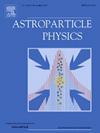Characterizing interplanetary magnetic field fluctuations at arctic using cosmic ray secondaries–An approach with machine learning
IF 2.9
3区 物理与天体物理
Q1 ASTRONOMY & ASTROPHYSICS
引用次数: 0
Abstract
This study explores the potential of ground-based cosmic ray measurements to quantify solar weather parameters, specifically the total interplanetary magnetic field (Bt). A compact Tissue Equivalent Proportional Counter (TEPC), meant for measuring radiation doses in human tissue, was set up at Ny-Ålesund near the North Pole, a region with zero geomagnetic cut-off, which allows for detailed measurements of the different components of cosmic rays. The TEPC continuously monitored low Linear Energy Transfer (LET) cosmic ray components, mainly electrons, and photons during two different seasons: January to March (winter) and September (summer) in 2024. Monte Carlo simulations using PHITS and EXPACS were carried out to understand the changes in cosmic ray flux related to solar weather. To model the relationship between cosmic ray flux and Bt, two machine learning algorithms were used: Gaussian Process Regression (GPR) and Artificial Neural Networks (ANN). Cosmic ray neutron data from the Oulu neutron monitor, which is part of the global neutron monitor network for studying solar weather, were included in the model. Adding the low LET data increased the R² value in the GPR model from 0.81 to 0.90 on the training data, and in the ANN model from 0.76 to 0.88 in comparison to only neutron data, showing a significant improvement in predictive ability. The results show a significant correlation between cosmic ray variations and Bt, suggesting that ground based cosmic ray data collected at low geomagnetic cut-offs—as captured by the TEPC in Ny-Ålesund, can be a reliable way to estimate Bt, especially when satellite data is unavailable. This approach offers a promising, cost-effective method for continuous solar weather monitoring, providing valuable insights into the effect of solar activity on cosmic rays, in turn, helping to make space-based technological systems more resilient.
利用次级宇宙射线表征北极行星际磁场波动——一种机器学习方法
本研究探索了地面宇宙射线测量的潜力,以量化太阳天气参数,特别是总行星际磁场(Bt)。一个紧凑的组织等效比例计数器(TEPC),用于测量人体组织中的辐射剂量,在靠近北极的Ny-Ålesund建立起来,这是一个没有地磁截止的地区,可以详细测量宇宙射线的不同成分。2024年1月至3月(冬季)和9月(夏季)两个季节,TEPC连续监测低线性能量转移(LET)宇宙射线成分,主要是电子和光子。利用PHITS和EXPACS进行了蒙特卡罗模拟,以了解与太阳天气有关的宇宙射线通量的变化。为了模拟宇宙射线通量与Bt之间的关系,使用了两种机器学习算法:高斯过程回归(GPR)和人工神经网络(ANN)。来自奥卢中子监测仪的宇宙射线中子数据包括在模型中,奥卢中子监测仪是研究太阳天气的全球中子监测网的一部分。加入低LET数据后,GPR模型对训练数据的R²值从0.81提高到0.90,ANN模型对中子数据的R²值从0.76提高到0.88,预测能力明显提高。结果显示宇宙射线变化与Bt之间存在显著的相关性,表明在低地磁截止点收集的地面宇宙射线数据(如纽约-Ålesund的TEPC所捕获的)可以是估计Bt的可靠方法,特别是在卫星数据不可用的情况下。这种方法为持续的太阳天气监测提供了一种有前途的、具有成本效益的方法,为太阳活动对宇宙射线的影响提供了有价值的见解,反过来又有助于使天基技术系统更具弹性。
本文章由计算机程序翻译,如有差异,请以英文原文为准。
求助全文
约1分钟内获得全文
求助全文
来源期刊

Astroparticle Physics
地学天文-天文与天体物理
CiteScore
8.00
自引率
2.90%
发文量
41
审稿时长
79 days
期刊介绍:
Astroparticle Physics publishes experimental and theoretical research papers in the interacting fields of Cosmic Ray Physics, Astronomy and Astrophysics, Cosmology and Particle Physics focusing on new developments in the following areas: High-energy cosmic-ray physics and astrophysics; Particle cosmology; Particle astrophysics; Related astrophysics: supernova, AGN, cosmic abundances, dark matter etc.; Gravitational waves; High-energy, VHE and UHE gamma-ray astronomy; High- and low-energy neutrino astronomy; Instrumentation and detector developments related to the above-mentioned fields.
 求助内容:
求助内容: 应助结果提醒方式:
应助结果提醒方式:


